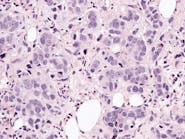Phase I clinical trial shows treatment designed to clear senescent cells in Alzheimer's disease is safe
Alzheimer’s disease is the most common cause of dementia that affects more than 6.5 million Americans, according to the Alzheimer’s Association. To find effective treatments and slow the progression of this debilitating disease, researchers have made much progress in developing new drugs that target beta-amyloid plaques, one of the hallmarks of Alzheimer’s disease.
Beta-amyloid plaques are accumulations of brain protein fragments, which can impact cognition. However, these recent drugs have only yielded modest results.
Now, scientists at Wake Forest University School of Medicine are reporting results from a Phase I trial in another area of promising research— cellular senescence.
The findings appear online in Nature Medicine.
Researchers repurposed a U.S. Food and Drug Administration-approved drug designed to clear cancer cells (dasatinib) in combination with a flavonoid, a plant-derived antioxidant (quercetin).
For the current study, which was co-led by Mitzi Gonzales, Ph.D., of The University of Texas Health Science Center at San Antonio, the research team enrolled five participants aged 65 and older with symptoms of early-stage Alzheimer’s disease. Participants received oral dasatinib plus quercetin over two consecutive days, followed by two weeks of no drugs. The cycle repeated six times for a total of 12 weeks.
The research team also collected data on the safety and efficacy of the two drugs by monitoring side effects. They assessed biomarkers of senescence in CSF and blood, and also evaluated patients’ cognition and brain images before treatment and after they completed the 12-week study.
They found that both dasatinib and quercetin levels increased in the blood, and dasatinib was detected in the CSF in four subjects. Quercetin was not detected in the CSF of any participants.
Researchers also saw evidence to suggest that the combination therapy cleared amyloid from the brain and lowered inflammation in the blood.
Researchers also noted an increase in inflammation in CSF biomarkers. According to Orr, one possible explanation is a transient increase in inflammation when senescent cells are cleared. This increase could also be a marker of senescent cells dying or could potentially indicate inflammation associated with the treatment.
Wake Forest University School of Medicine release on Newswise





